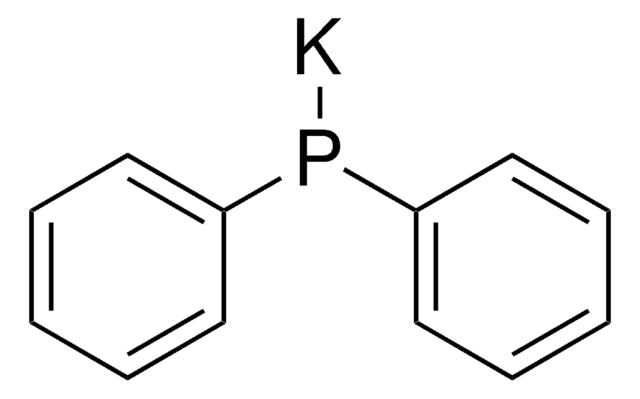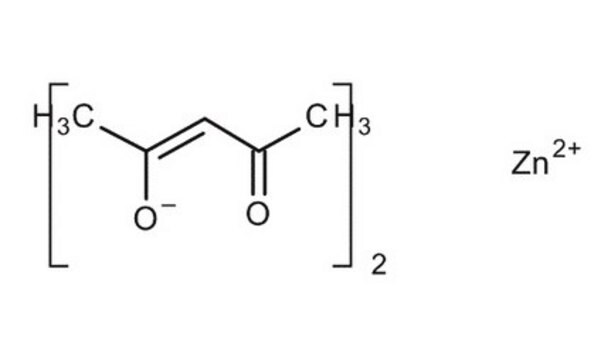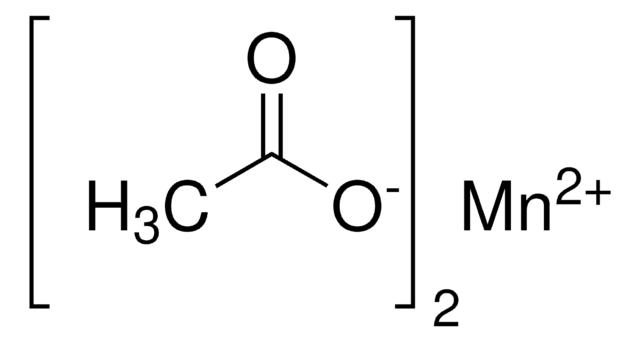추천 제품
일반 설명
Zinc acetate is primarily utilized as a precursor or catalyst in various synthetic reactions. In organic chemistry, zinc acetate finds application as a reagent in the formation of carbon-carbon bonds. It can facilitate the synthesis of esters, allylic alcohols, and acetals. For example, it can promote the acylation of alcohols, phenols, and amines to form esters, such as the Fischer esterification reaction. Zinc acetate has also been used in the synthesis of metal-organic frameworks (MOFs). MOFs are porous materials consisting of metal ions or clusters coordinated to organic ligands. Zinc acetate can act as a precursor for the formation of MOFs due to its ability to coordinate with organic linkers and form robust networks.
For small scale and high throughput uses, product is also available as ChemBeads (927805)
For small scale and high throughput uses, product is also available as ChemBeads (927805)
애플리케이션
Zinc acetate has been used in:
- Synthesis of layered Zn-arylphosphonates with potential application in sorption, ion exchange or catalysis.
- Ultrasonic preparation of zinc sulfide nanoparticles coated on silica particles.
- Synthesis of ZnO/ZnS composites throughion exchange method (1)
- Fabrication of 3D hierarchical ZnO/ZnSheterojunction branched nanowires for enhanced photoelectrochemical watersplitting (2)
- Synthesis of Co3O4-decorated ZnO@ZnS core-shellstructures for efficient photocatalytic overall water splitting (3)
- Synthesis of ZnO photocatalysts (4)
제조 메모
Preparation of ZnSe nanostructures upon thermolysis of zinc acetate and selenourea in a mixture of octadecylamine and trioctylphosphine oxide.
신호어
Danger
유해 및 위험 성명서
Hazard Classifications
Acute Tox. 4 Oral - Aquatic Chronic 2 - Eye Dam. 1
Storage Class Code
11 - Combustible Solids
WGK
WGK 3
Flash Point (°F)
Not applicable
Flash Point (°C)
Not applicable
개인 보호 장비
dust mask type N95 (US), Eyeshields, Gloves
이미 열람한 고객
Junsang Cho et al.
Langmuir : the ACS journal of surfaces and colloids, 33(15), 3711-3719 (2017-04-01)
Highly efficient blue-emitting CdSe-derived core/shell gradient alloy quantum dots (CSGA QDs) with photoluminescence quantum yield (PL QY) of ca. 90% have been synthesized through a facile "one-pot" approach. CdSe nuclei are initially formed as core and gradient alloy shells such
Abdelhay Aboulaich et al.
Inorganic chemistry, 49(23), 10940-10948 (2010-11-06)
Relatively monodisperse and highly luminescent Mn(2+)-doped zinc blende ZnSe nanocrystals were synthesized in aqueous solution at 100 °C using the nucleation-doping strategy. The effects of the experimental conditions and of the ligand on the synthesis of nanocrystals were investigated systematically.
Siu-Hong Chan et al.
PloS one, 5(2), e9071-e9071 (2010-02-09)
Helicobacter pylori is the etiologic agent of common gastritis and a risk factor for gastric cancer. It is also one of the richest sources of Type II restriction-modification (R-M) systems in microorganisms. We have cloned, expressed and purified a new
Asit Baran Panda et al.
Langmuir : the ACS journal of surfaces and colloids, 23(2), 765-770 (2007-01-11)
Shape-, size-, and phase-controlled ZnSe nanostructures were synthesized by thermolysis of zinc acetate and selenourea using liganding solvents of octadecylamine (ODA) and trioctylphosphineoxide (TOPO) at different molar ratios. Materials synthesized in pure ODA resulted in uniform ultranarrow nanorods and nanowires
Huiqing Wang et al.
Cellulose (London, England), 20(6), 3007-3024 (2013-01-01)
Photoluminiscent (PL) cellulose aerogels of variable shape containing homogeneously dispersed and surface-immobilized alloyed (ZnS)
자사의 과학자팀은 생명 과학, 재료 과학, 화학 합성, 크로마토그래피, 분석 및 기타 많은 영역을 포함한 모든 과학 분야에 경험이 있습니다..
고객지원팀으로 연락바랍니다.












